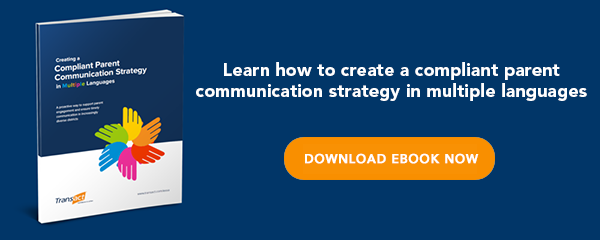 As an education professional, you have no doubt heard about the Every Student Succeeds Act, or ESSA — the reauthorization to the Elementary and Secondary Education Act (ESEA) that was signed into law in December of 2015.
As an education professional, you have no doubt heard about the Every Student Succeeds Act, or ESSA — the reauthorization to the Elementary and Secondary Education Act (ESEA) that was signed into law in December of 2015.
The new legislation didn’t officially take effect until the 2017-2018 school year, but there’s still a lot to learn — especially when it comes to supporting parent communication in multiple languages.
The 2016/2017 school year was a transition year between No Child Left Behind (NCLB) and ESSA, and some requirements are bound to change. At this time, we know that parent notifications are indeed still required, and that they remain mostly aligned with former NCLB requirements. The parent notifications still required before ESSA goes into effect include those involving parent involvement, teacher quality, Title I schoolwide eligibility, unsafe schools, privacy rights, and homeless education, to name a few.
Especially when it comes to communicating with students’ parents and families who speak a language other than English, it’s critical to have a solid strategy in place. As the federal law transitions over the upcoming school year, there’s no better time to outline a strategy for the future.
Outline a strategy
When it comes to relaying important and federally mandated information between school and home, written notifications are essential. According to the law, all school districts must provide parent notification documents in languages the students’ parents can understand – English or otherwise. These languages can easily differ from district to district.
When it comes to parent communication strategies, most districts fall into one of three categories:
- Those who have no multi-language parent communication strategy in place
- Those who manage their own communication strategy internally
- Those who outsource the translation to a communication strategy management company
If you have a strategy now, ask yourself how well it’s working. Are parents satisfied and informed? Are you effectively building relationships across cultural and language boundaries? If you don’t have a system now, what’s keeping you from implementing one?
If you don’t yet have a multi-language communication plan or are dissatisfied with your current system, now is the time to make changes. Being proactive not only helps develop better relationships and community between school and home, but helps your district set a foundation for compliance going forward.
Allocate adequate resources
One of the biggest perceived roadblocks to developing a compliant multi-language communications strategy is the resources required. Managing an internal strategy often involves hiring someone who can accurately translate documents into different languages — or, for many, asking a trained staff or faculty member to translate documents on the school’s behalf.
However, transferring the burden of translation to existing staff members has its risks. On top of their regular job duties, this task can overwhelm those responsible and take their focus off student success. Worse, relying on students or parent volunteers can lead to breaches of confidentiality and compliance.
For many, choosing a comprehensive partner organization that translates, legally reviews, and effectively distributes documents for easy access is the best and most cost-effective strategy.
Execute a delivery plan
To elaborate, a key component of any communication system is distributing the information. The same is true for a multi-language communication strategy — that is, making it accessible to administrators and faculty as needed.
As the ESSA reauthorization takes effect, districts will benefit from having a storage and delivery process in place to manage documents, access them as needed, and send them out in a timely fashion. While many districts choose to manage this themselves, updating the library and communicating about any changes requires legal and contextual expertise, and can be a burden, requiring extra time from an internal administrator. With a comprehensive solution, it’s all taken care of for you — a real time-saver in a year where so many of the current requirements are subject to change.
In a time of uncertain federal requirements and shifting leadership, it can be tough to know all the answers. When it comes to communicating with parents and families, including those who speak a language other than English, the first step is to lay the foundation of a strong communication system. As new federal regulations become more clear in the forthcoming school year, now may be the best time to investigate a comprehensive parent communication partner to help you achieve compliance consistently and with confidence.
Learn more about how TransACT can help your school district prepare for ESSA by downloading our ebook.




